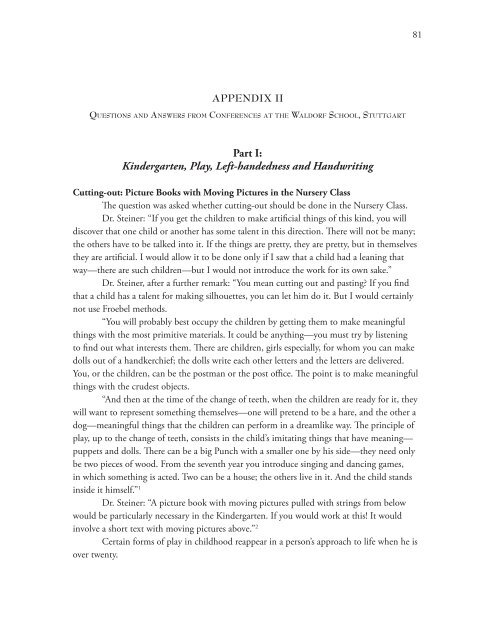Handwork and Handicrafts - Waldorf Research Institute
Handwork and Handicrafts - Waldorf Research Institute
Handwork and Handicrafts - Waldorf Research Institute
You also want an ePaper? Increase the reach of your titles
YUMPU automatically turns print PDFs into web optimized ePapers that Google loves.
81<br />
APPENDIX II<br />
Questions <strong>and</strong> Answers from Conferences at the <strong>Waldorf</strong> School, Stuttgart<br />
Part I:<br />
Kindergarten, Play, Left-h<strong>and</strong>edness <strong>and</strong> H<strong>and</strong>writing<br />
Cutting-out: Picture Books with Moving Pictures in the Nursery Class<br />
The question was asked whether cutting-out should be done in the Nursery Class.<br />
Dr. Steiner: “If you get the children to make artificial things of this kind, you will<br />
discover that one child or another has some talent in this direction. There will not be many;<br />
the others have to be talked into it. If the things are pretty, they are pretty, but in themselves<br />
they are artificial. I would allow it to be done only if I saw that a child had a leaning that<br />
way—there are such children—but I would not introduce the work for its own sake.”<br />
Dr. Steiner, after a further remark: “You mean cutting out <strong>and</strong> pasting? If you find<br />
that a child has a talent for making silhouettes, you can let him do it. But I would certainly<br />
not use Froebel methods.<br />
“You will probably best occupy the children by getting them to make meaningful<br />
things with the most primitive materials. It could be anything—you must try by listening<br />
to find out what interests them. There are children, girls especially, for whom you can make<br />
dolls out of a h<strong>and</strong>kerchief; the dolls write each other letters <strong>and</strong> the letters are delivered.<br />
You, or the children, can be the postman or the post office. The point is to make meaningful<br />
things with the crudest objects.<br />
“And then at the time of the change of teeth, when the children are ready for it, they<br />
will want to represent something themselves—one will pretend to be a hare, <strong>and</strong> the other a<br />
dog—meaningful things that the children can perform in a dreamlike way. The principle of<br />
play, up to the change of teeth, consists in the child’s imitating things that have meaning—<br />
puppets <strong>and</strong> dolls. There can be a big Punch with a smaller one by his side—they need only<br />
be two pieces of wood. From the seventh year you introduce singing <strong>and</strong> dancing games,<br />
in which something is acted. Two can be a house; the others live in it. And the child st<strong>and</strong>s<br />
inside it himself.” 1<br />
Dr. Steiner: “A picture book with moving pictures pulled with strings from below<br />
would be particularly necessary in the Kindergarten. If you would work at this! It would<br />
involve a short text with moving pictures above.” 2<br />
Certain forms of play in childhood reappear in a person’s approach to life when he is<br />
over twenty.

















